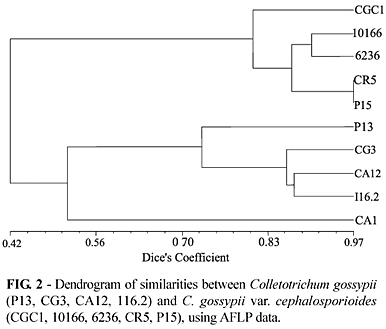Fungal diseases in cotton (Gossypium hirsutum), such as anthracnose caused by Colletotrichum gossypii and ramulose caused by C. gossypii var. cephalosporioides, are responsible for large yield losses. These pathogens are seed borne and morphologically similar although they induce different symptoms, which can lead to misdiagnosis using the blotter testing method. The present study was carried out to assess the viability of using Amplified Fragment Length Polymorphism (AFLP) markers to differentiate these pathogens. Five isolates, for each pathogen, were classified according to pathogenicity on cotton plants, and mycelial growth morphology. Conidial suspensions were sprayed on 30-day-old cotton plants and the symptoms assessed ten and 40 days after inoculation. For growth morphology 200 cottonseeds were inoculated with seven-day-old pure cultures, and the mycelial traits observed under a stereoscopic microscope seven days after inoculation. The DNA for AFLP analysis was obtained from seven-day-old fungal mycelia grown in liquid medium, using the Dneasy Qiagen protocol. Using the AFLP technique 318 polymorphic bands were selected to estimate similarities using Dice's Coefficient. The results clearly distinguished between ramulose and anthracnose isolates, which agreed with morphological and pathogenicity testing.
molecular markers; anthracnose; ramulose; cotton diseases; seed borne pathogens



